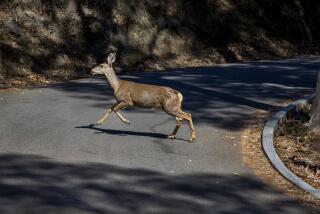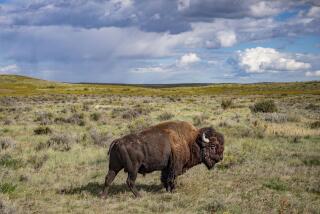BEYOND BEEF : THE EXOTICS : Game on the Range
- Share via
INGRAM, Tex. — “This is real sorry ranch land--very little rain, lots of rocks, not much topsoil and an overall damned poor place to graze cattle,” says Mike Hughes, looking out over the rolling hills dotted with cedar and Spanish oak. “You need as much as 30 acres of land to provide enough browse to raise just one cow.”
Even so, since the 1940s gentlemen ranchers have found west central Texas’s mild climate and handsome terrain the perfect refuge from high-density cities and executive-level job stress.
The result was the birth of sprawling weekend or vacation estates more than a century after the area was settled by German immigrants determined to scratch out a living in the cattle or dairy business, despite the reluctant environment.
The new wave of gentry, however, added a twist to the usual gentleman farmer mixture of grand chateaux, imposing iron entry gates and home lots measured in thousands of acres. They added wild game.
*
The inspiration, some believe, came from William Randolph Hearst, who populated the grounds of his San Simeon castle with zebras and the like. Others think the animals were imported to give Texas some of the same flair as Africa’s savannas, the great ranges that American tourists discovered during the hunting safaris of the early 1900s.
The animals were brought from Africa, the Indian subcontinent and Asia. The more exotic the better. And overcrowded American zoos also sold surplus. The Texas Hill Country, as the area is known, proved to be an ideal habitat for blackbuck antelope, Axis deer, wild boar, elk, fallow deer and other game animals that adapted well and multiplied. (The native American deer is legally protected and cannot be commercially hunted.)
The transplantation turned out to be an environmental success as well. Game use water more efficiently, eat a more diverse plant and vegetative diet and do not cause as much soil erosion as traditional cattle. Blackbuck antelopes, for one, have thrived and number about 150,000 in Texas--more than survive in their native India, says Hughes.
Though the animals were initially purchased by Texans for sport, hunting was impractical because it took too much time for the game to reproduce to the point where a weekend of shooting would not wipe out a rancher’s entire stock. Others wanted the game simply for aesthetics.
*
Twelve years ago, Hughes developed an entirely different plan for the game: to harvest and market the meat from the burgeoning population of exotic animals to upscale restaurants and consumers.
Hughes, a bear of a man at 6 feet, 4 inches, retells the story while flipping a 1783 Spanish silver coin he recently recovered from a 200-year-old shipwreck in the Caribbean. (In his first career, Hughes founded and operated Oceaneering International Inc., which was involved in some of the most famous deep-sea salvage operations in recent history, including the World War I passenger ship Lusitania and the wreckage of the space shuttle Challenger.)
“My mother said that I was never a good swimmer, and yet I became a professional diver. Then, 30 years later, she said that I never was interested in hunting or guns, but here I am now killing animals for a living,” says Hughes, sitting in a bungalow-style office decorated with animal skins, the mounted head of a Longhorn steer and all sorts of deep-sea diving paraphernalia.
*
In 1983, Hughes and a single employee began the company now known as Broken Arrow Ranch, named after Hughes’ own 700-acre homestead where game and cattle coexist.
First, Hughes had to persuad a few neighbors to allow him access to their land to hunt their surplus animals. It was a controversial initiative because the game were sometimes considered pets and people became attached to them. However, the game animals thrived in the Texas climate and eventually proved to be too many for even the Hill Country’s large ranches. “There was no process to control the growing numbers of wild game,” he says.
“The landowners did not want hunters prowling their land, shooting the animals and then leaving them there. Surplus animals being taken by us was a welcome idea and we received a ready reception. We were not cowboys racing around in trucks for fun; nor were we some scruffs,” says Hughes. “We work cleanly and professionally. . . . Bottom line was, despite the wealth, these ranchers were not philanthropists.”
Of course, the hard truth about Hughes’ business is that the animals are shot by marksmen with a Steyr Mannlicher .308-caliber rifle with a silencer.
“Anyone who believes that eating meat is OK would not have a problem with our products,” he says. “As a matter of fact, I believe our harvesting is more humane and purer than is the case for traditional meat. We shoot the animals once--in the head--and they are not allowed to suffer. It eliminates stress and improves the quality of the meat.”
*
There is a growing farmed venison industry in this country and a much larger, similar operation in New Zealand that also exports to the United States. But unlike the game he sells, farm-raised animals are not considered wild by any means, says Hughes.
The difference is that the domesticated breed is entirely dependent upon humans for feed, water and shelter. The so-called wild animals forage on their own as in their natural habitat; this gives the meat its distinctive characteristic.
In the mid-1980s, the American restaurant industry was in its heyday, with people willing to spend money on virtually anything novel or exotic. However, no one, and certainly not deep-sea diver Hughes, knew if the American consumer would be as open to game meats as, say, Europeans.
In “American Game Cooking” (Aris Books: 1993) co-authors John Ash and Sid Goldstein write: “It is ironic that game should be thought of as a new culinary trend since game dishes are the oldest legacy of our cooking heritage. Yet, for most of America over the past few decades, with the exception of the occasional Thanksgiving or Christmas bird, game has been all but nonexistent at the nation’s table.”
Ash, who is executive chef of the Fetzer Food & Wine Center in Hopland, Calif., says the meat of game animals is as “near to nature as anything.
“Game is not genetically manipulated. There is no use of chemicals, growth hormones or antibiotics,” he says. “It’s very healthy stuff with an interesting and delicate flavor.”
*
Game’s nutritional profile is excellent: Most Broken Arrow cuts are extremely lean, with only about 2% fat.
And so Hughes began the tedious job of marketing his wild game; first in Houston and then New York.
He tells a story of walking from one top Manhattan restaurant to another with a cooler full of Nilgai deer loin. One of his stops was at Lutece, where chef Andre Soltner agreed to meet with him but complained that the game was too lean and too expensive in comparison to European varieties. Soltner bought one deer leg but never another, Hughes says.
Those tentative days of pounding the sidewalk are over. Broken Arrow Ranch is now a sophisticated harvester and processor of wild game with 24 employees, state-of-the-art equipment and overnight shipping. All carcasses are inspected by the Texas Department of Health.
*
More than 2,000 of the nation’s restaurants are customers, including Parkway Grill in Pasadena, Bernard’s at the Biltmore Hotel in Los Angeles, and the Four Seasons Hotel. Broken Arrow also sells to some top retail outlets, including Neiman-Marcus, and offers numerous products to the public through a toll-free number (800) 962-4263.
“No one else does what we do today,” Hughes says. “We harvest more than 4,000 animals per year, and our competitors--in New York, Minnesota, Iowa and Illinois--would be considered large operations if any of them processed 200 animals (in the same time).”
More to Read
Sign up for The Wild
We’ll help you find the best places to hike, bike and run, as well as the perfect silent spots for meditation and yoga.
You may occasionally receive promotional content from the Los Angeles Times.






